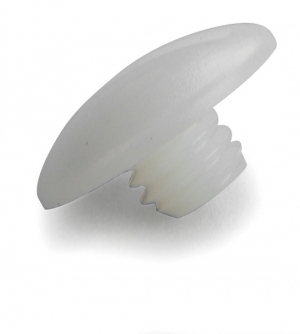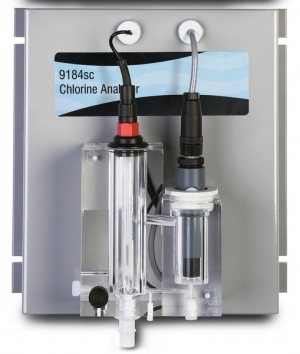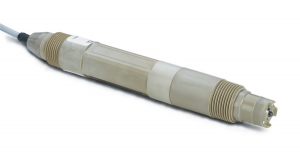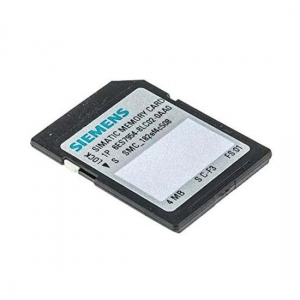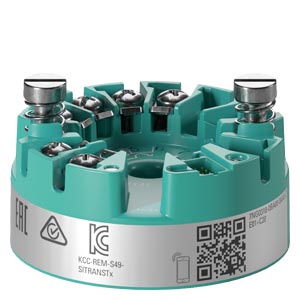General | |
Supply voltage1) 2) | |
- Without explosion protection (non-Ex)
| 7.5 ... 48 V DC |
- With explosion protection (Ex i)
| 7.5 ... 30 V DC |
Additional minimum supply voltage when using test terminals | 0.8 V |
Maximum power loss | ≤ 850 mW |
Minimum load resistance at supply voltage > 37 V | (Vsupply - 37 V)/23 mA |
Insulation voltage, test/operation | |
- Without explosion protection (non-Ex)
| 2.5 kV AC/55 V AC |
- With explosion protection (Ex i)
| 2.5 kV AC/42 V AC |
Polarity protection | All inputs and outputs |
Write protection | Wire jumpers or software |
Warm-up time | < 5 min |
Starting time | < 2.75 s |
Programming | HART |
Signal-to-noise ratio | > 60 dB |
Long-term stability | Better than: - ± 0.05% of measuring span/year
- ± 0.18% of measuring span/5 years
|
Response time | 4 ... 20 mA: ≤ 55 ms HART: ≤ 75 ms (typically 70 ms) |
Programmable damping | 0 ... 60 s |
Signal dynamic | |
| 24 bit |
| 18 bit |
Influence of change in supply voltage | < 0.005% of measuring span/V DC |
Input | |
Resistance thermometer (RTD) | |
Input type | |
| - IEC 60751
- JIS C 1604‑8
- GOST 6651_2009
- Callendar-Van Dusen
|
| - DIN 43760-1987
- GOST 6651-2009/OIML R84:2003
|
| - Edison Copper Winding No. 15
- GOST 6651‑2009/OIML R84:2003
|
Connection type | 2-wire, 3-wire or 4-wire |
Wire resistance per wire | Max. 50 Ω |
Input current | < 0.15 mA |
Effect of the wire resistance (with 3-wire and 4-wire connections) | < 0.002 Ω/Ω |
Cable, wire-wire capacity | |
- Pt1000, Pt10000 (IEC 60751 and JIS C 1604‑8)
| Max. 30 nF |
| Max. 50 nF |
Fault detection, programmable | None, short-circuited, defective, short-circuited or defective Note When the low limit for the configured input type is below the constant detection limit for short-circuited inputs, the detection of short circuits is disabled regardless of the configuration of the fault detection. |
Detection limit for short-circuited input | 15 Ω |
Fault detection time (RTD) | ≤ 75 ms (typically 70 ms) |
Fault detection time (for 3-wire and 4-wire) | ≤ 2 000 ms |
Thermocouples (TC) | |
Input type | |
| IEC 60584‑1 |
| IEC 60584‑1 |
| IEC 60584‑1 |
| IEC 60584‑1 |
| DIN 43710 |
| GOST 3044‑84 |
| IEC 60584‑1 |
| IEC 60584‑1 |
| IEC 60584‑1 |
| IEC 60584‑1 |
| DIN 43710 |
| ASTM E988‑96 |
| ASTM E988‑96 |
| GOST 3044‑84 |
Cold junction compensation (CJC) | Constant, internal or external over Pt100 or Ni100 RTD |
- Temperature range internal CJC
| -50 ... +100 °C (-58 ... +212 °F) |
| 2-wire or 3-wire |
- External CJC, wire resistance per wire (for 3-wire and 4-wire connections)
| 50 Ω |
- Effect of the wire resistance (with 3-wire and 4-wire connections)
| < 0.002 Ω/Ω |
- Input current external CJC
| < 0.15 mA |
- Temperature range external CJC
| ‑50 ... +135 °C (‑58 ... +275 °F) |
- Cable, wire-wire capacity
| Max. 50 nF |
| Max. 10 kΩ |
- Fault detection, programmable
| None, short-circuited, defective, short-circuited or defective Note The short-circuited fault detection only applies to the CJC input. |
- Fault detection time (TC)
| ≤ 75 ms (typically 70 ms) |
- Fault detection time, external CJC (for 3-wire and 4-wire)
| ≤ 2 000 ms |
Linear resistance | |
Input range | 0 ... 100 kΩ |
Minimum measuring span | 25 Ω |
Connection type | 2-wire, 3-wire or 4-wire |
Wire resistance per wire | Max. 50 Ω |
Input current | < 0.15 mA |
Effect of the wire resistance (with 3-wire and 4-wire connections) | < 0.002 Ω/Ω |
Cable, wire-wire capacity | |
| Max. 30 nF |
| Max. 50 nF |
Fault detection, programmable | None, defective |
Potentiometers | |
Input range | 10 ... 100 kΩ |
Minimum measuring span | 25 Ω |
Connection type | 3-wire or 4-wire |
Wire resistance per wire | Max. 50 Ω |
Input current | < 0.15 mA |
Effect of the wire resistance (with 4-wire and 5-wire connections) | < 0.002 Ω/Ω |
Cable, wire-wire capacity | |
| Max. 30 nF |
| Max. 50 nF |
Fault detection, programmable | None, short-circuited, defective, short-circuited or defective Note When the configured potentiometer size is below the constant detection limit for short-circuited inputs, the detection of short circuits is disabled regardless of the configuration of the fault detection. |
Detection limit for short-circuited input | 15 Ω |
Fault detection time, wiper arm (no short-circuit detection) | ≤ 75 ms (typically 70 ms) |
Fault detection time, element | ≤ 2 000 ms |
Fault detection time (for 4-wire and 5-wire) | ≤ 2 000 ms |
Voltage input | |
Measuring range | |
| ‑100 ... 1700 mV |
| ‑800 ... +800 mV |
Minimum measuring span | 2.5 mV |
Input resistance | 10 MΩ |
Cable, wire-wire capacity | |
- Input range: ‑100 ... 1700 mV
| Max. 30 nF |
- Input range: ‑20 ... 100 mV
| Max. 50 nF |
Fault detection, programmable | None, defective |
Fault detection time | ≤ 75 ms (typically 70 ms) |
Output and HART communication | |
Normal range, programmable | 3.8 ... 20.5 mA/20.5 ... 3.8 mA |
Extended range (output limits), programmable | 3.5 ... 23 mA/23 ... 3.5 mA |
Programmable input/output limits | |
| Enable/disable |
| 3.5 ... 23 mA |
Update time | 10 ms |
Load (with current output) | ≤ (VSupply - 7.5)/0.023 Ω |
Load stability | < 0.01% of measuring span/100 Ω
(measuring span = currently selected range) |
Input fault detection, programmable
(detection of input short-circuits is ignored with TC and voltage inputs) | 3.5 ... 23 mA |
NAMUR NE43 Upscale | > 21 mA |
NAMUR NE43 Downscale | < 3.6 mA |
HART protocol versions | HART 7 |
Measuring accuracy | |
Input accuracy | See "Input accuracy" table |
Output accuracy | See "Output accuracy" table |
Operating conditions | |
Ambient temperature | ‑50 ... +85 °C (‑58 ... +185 °F) |
Ambient temperature for devices with functional safety | ‑40 ... +80 °C (‑40 ... +176 °F) |
Storage temperature | ‑50 ... +85 °C (‑58 ... +185 °F) |
Reference temperature for sensor calibration | 24 °C ±1.0 °C (75.2 °F ±1.8 °F) |
Relative humidity | < 99% (no condensation) |
Degree of protection | |
| IP68 |
| IP00 |
Structural design | |
Weight | 50 g (0.11 lb) |
Maximum core cross-section | 1 × 1.5 mm² (stranded wire) |
Tightening torque for clamping screws | 0.4 Nm |
Vibrations | IEC 60068‑2‑6 |
| ± 1.6 mm (0.07 inches) |
| ± 4 g |
Certificates and approvals | |
Explosion protection ATEX/IECEx and others | |
Certificates3) | - DEKRA 17ATEX0116 X
- IECEx DEK 17.0054X
- A5E43700604A-2018X
|
"Intrinsic safety ia/ib" type of protection | For use in Zone 0, 1, 2, 20, 21, 22 |
| - II 1 G Ex ia IIC T6 ... T4 Ga
- II 2(1) G Ex ib [ia Ga] IIC T6 ... T4 Gb
- II 2 D Ex ia IIIC Db
- I M1 Ex ia I Ma
|
| - Ex ia IIC T6 ... T4 Ga
- Ex ib [ia Ga] IIC T6 ... T4 Gb
- Ex ia IIIC Db
- Ex ia I Ma
|
"Intrinsic safety ic" type of protection | For use in Zones 2 and 22 |
| - II 3 G Ex ic IIC T6…T4 Gc
- II 3 D Ex ic IIIC Dc
|
| - Ex ic IIC T6 ... T4 Gc
- Ex ic IIIC Dc
|
"Non-sparking/increased safety nA/ec" type of protection | For use in Zones 2 and 22 |
| - II 3 G Ex nA IIC T6…T4 Gc
- II 3 G Ex ec IIC T6…T4 Gc
|
| - Ex nA IIC T6 ... T4 Gc
- Ex ec IIC T6 ... T4 Gc
|
Explosion protection CSA/FM for Canada and USA | |
Certificates | - CSA 1861385
- FM18CA0024
- FM18US0046
|
"Intrinsic safety ia" type of protection | - IS, CL I, Div 1, GP ABCD, T6 ... T4
- Ex ia IIC T6 … T4 Ga, AEx ia IIC T6 … T4 Ga
or
Ex ib [ia Ga] IIC T6…T4 Gb, AEx ib [ia Ga] IIC T6…T4 Gb
|
"Non incendive field wiring NIFW" type of protection | NIFW, CL I, Div 2, GP ABCD T6 ... T4 |
"Non incendive NI" type of protection | - NI, CL I, Div 2, GP ABCD T6...T4
- Ex nA IIC T6 ... T4 Gc
- AEx nA IIC T6 ... T4 Gc
|




 Giỏ hàng
Giỏ hàng  Danh mục sản phẩm
Danh mục sản phẩm
